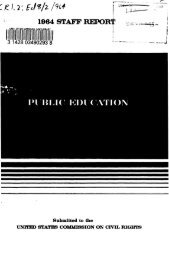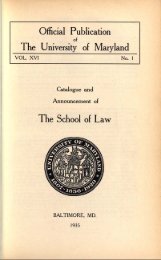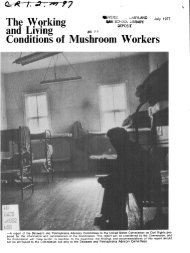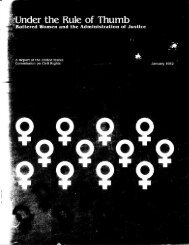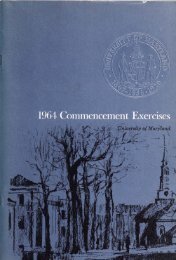1961 US Commission on Civil Rights Report Book 2 - University of ...
1961 US Commission on Civil Rights Report Book 2 - University of ...
1961 US Commission on Civil Rights Report Book 2 - University of ...
Create successful ePaper yourself
Turn your PDF publications into a flip-book with our unique Google optimized e-Paper software.
desegregati<strong>on</strong>, have found it an excellent instrument to provide for the<br />
slow, low-achieving students without hurting others.<br />
By classes.—Some educators str<strong>on</strong>gly c<strong>on</strong>demn the track system because<br />
it virtually freezes each student in a track in accordance with admittedly<br />
fallible testing methods. Intraschool ability grouping by classes<br />
for able, average, and slow learners meets this objecti<strong>on</strong>. Proven performance<br />
in each subject is the basis <strong>of</strong> classificati<strong>on</strong>. A child in an<br />
advanced class in science or mathematics may be in a slow class in<br />
English. Thus, an overall classificati<strong>on</strong> <strong>of</strong> bright, average, or dull is<br />
avoided. This kind <strong>of</strong> grouping has been useful in c<strong>on</strong>necti<strong>on</strong> with<br />
desegregati<strong>on</strong>. 9 Of course, it can be used <strong>on</strong>ly in schools having two or<br />
more classes in the same subject.<br />
Special classes in English, 10 n<strong>on</strong>graded classes for overage students, 11<br />
and other remedial classes 12 seem to fall in this category, although <strong>on</strong>ly<br />
the lower level <strong>of</strong> the achievement range is singled out for attenti<strong>on</strong>.<br />
Sometimes such classes in desegregated schools in fact serve Negro students<br />
almost exclusively. 13<br />
Ability groups within a class can be used in schools having <strong>on</strong>ly <strong>on</strong>e<br />
class <strong>of</strong> a particular grade, or subject. N<strong>on</strong>e <strong>of</strong> the educators attending<br />
the <str<strong>on</strong>g>Commissi<strong>on</strong></str<strong>on</strong>g>'s three educati<strong>on</strong> c<strong>on</strong>ferences discussed this method.<br />
However split classes are a variant <strong>of</strong> the ability-group-within-the-class<br />
technique. The superintendent <strong>of</strong> schools <strong>of</strong> M<strong>on</strong>tgomery County, Md.,<br />
testified at the <str<strong>on</strong>g>Commissi<strong>on</strong></str<strong>on</strong>g>'s Gatlinburg c<strong>on</strong>ference that he had used this<br />
method in an elementary school where most students were average or<br />
below, while a few were highly talented. Under this plan 14 —<br />
. . . the bulk <strong>of</strong> the students are in regular class by grade and the<br />
top <strong>of</strong> each class has been put into a split class, so that we have a<br />
group <strong>of</strong> first and sec<strong>on</strong>d graders with <strong>on</strong>e teacher, third and fourth<br />
with <strong>on</strong>e, fifth and sixth with <strong>on</strong>e. These are the academically talented<br />
students, both Negro and whites, who are in that school, and<br />
they move al<strong>on</strong>g <strong>on</strong> this level and the others at the different rate<br />
move al<strong>on</strong>g in the regular classes.<br />
Supervised home study<br />
Tutoring <strong>of</strong> the handicapped Negro pupil newly enrolled in a formerly<br />
all-white school has been provided both <strong>of</strong>ficially and privately. The<br />
superintendent <strong>of</strong> schools <strong>of</strong> San Angelo, Texas, told the <str<strong>on</strong>g>Commissi<strong>on</strong></str<strong>on</strong>g><br />
that Negro students in his city performed so poorly when transferred to<br />
a white high school that they requested segregati<strong>on</strong>. 15<br />
We believe this was brought <strong>on</strong> by their first report cards. At the<br />
end <strong>of</strong> the first 6 weeks, all grades given to Negro students represented<br />
8 A's, 13 B's, 37 C's, 13 D's, 20 F's, and 9 incomplete. This<br />
average was approximately 15 points lower than the grades the<br />
"9






